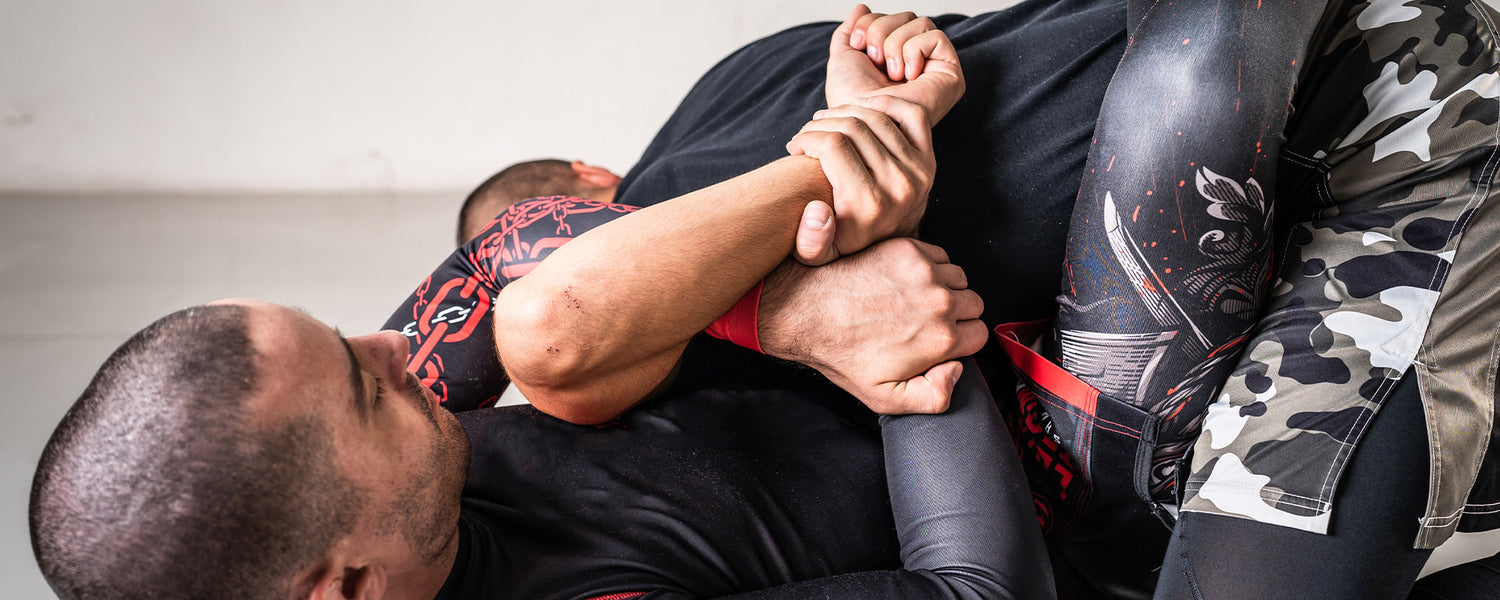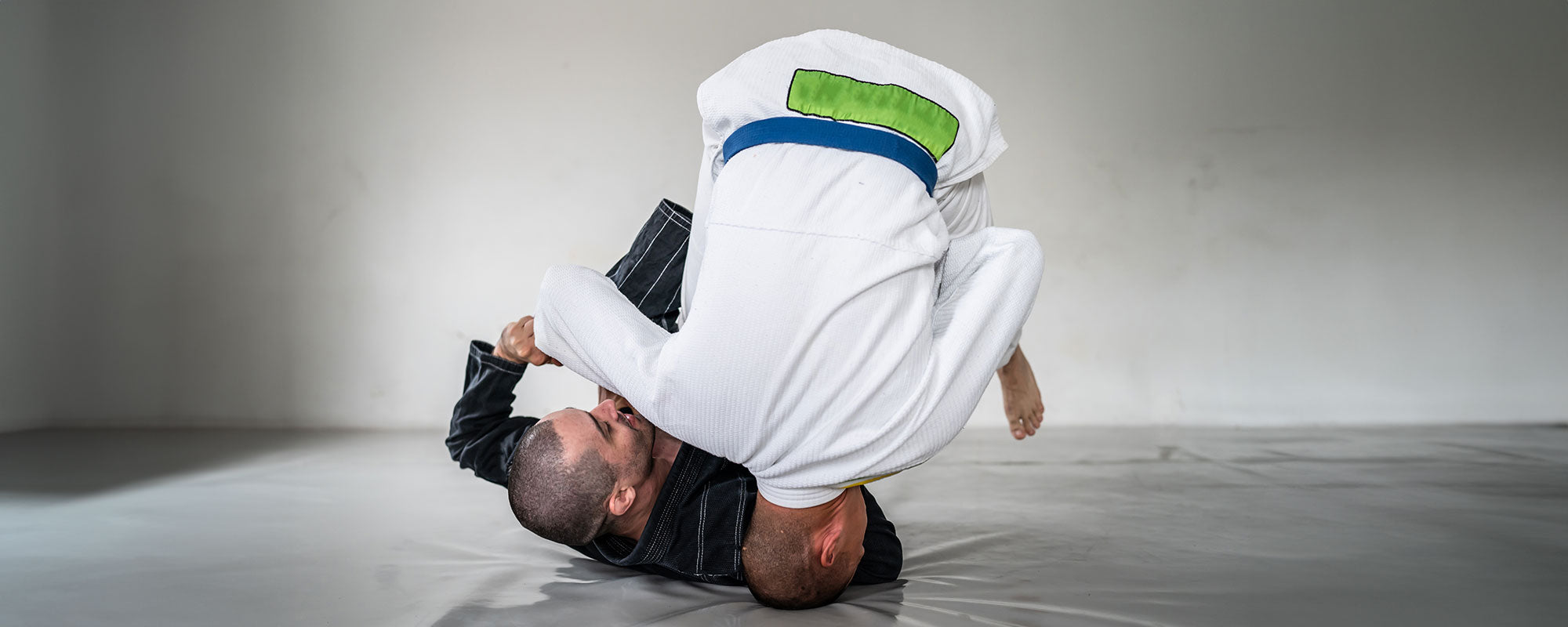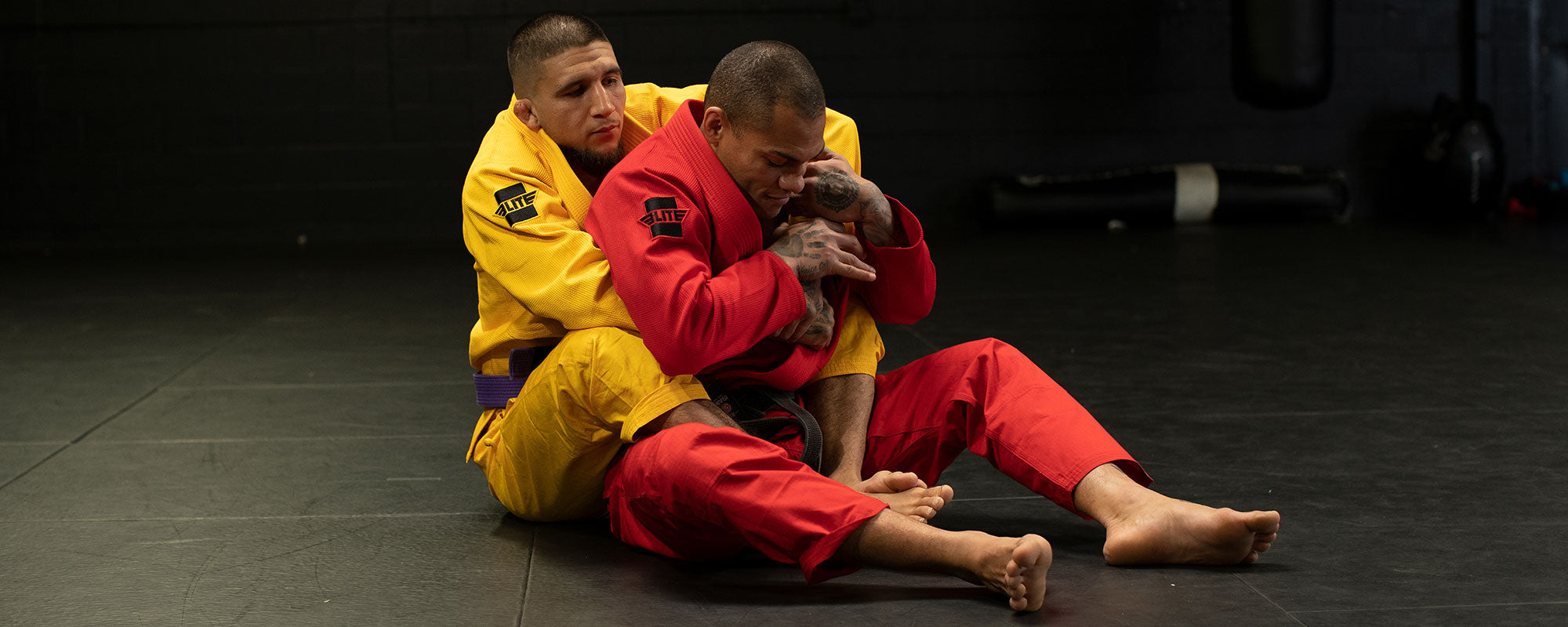Table of content
1. Introduction
1.1. What is Omoplata and its literal meaning in BJJ
The word omoplata, in basic Portuguese, means scapula or "shoulder blade." Over time, it has become sufficient for a BJJ submission hold due to its ability to exert pressure on the opponent's shoulder blade, effectively compressing the arm. In that regard, omoplata is a versatile submission hold since it has worked from both top and bottom positions and is adaptable.
Omoplata or sankaku gourami-leg triangle entanglement is the name this coil lock takes in both judo and catch wrestling.
Omoplata is a move in which a BJJ player uses his legs and hips to hyper-extend an opponent's shoulder joint out of its normal range of motion and thus force him to submit. The shoulder lock resembles a Kimura lock ; without the figure-four grip, the player uses his legs to hold on to the submission.
1.2. Brief History
It was developed under Mitsuyo Maeda, a Japanese judoka. This has been around ever since Brazilian Jiu-Jitsu. The omoplata finally trickled down and was elevated by the family of Clark Gracie to become a legitimate submission move in BJJ. Over the years, the omoplata has been used in competitions like IBJJF as a benchmark, and it is quite popularly used by training in both gi and no-gi environments.
First, the omoplata is significant because it forms part of a submission technique applicable to several positions. This technique is potent for neutralizing opponents regardless of physical size or strength.
1.3. Importance of Omoplata in Brazilian Jiu-Jitsu
The omoplata is one of the fundamental techniques of submission grappling in Jiu-Jitsu. A quarter-century ago, it was one of the techniques first introduced to students in the martial arts world. Today, the omoplata has continuously been refined within modern Brazilian Jiu-Jitsu competitions . It is part of every Jiu-Jitsu academy curriculum.
2. Omoplata functionality in BJJ and MMA

2.1. Principle of the work of omoplata in BJJ in detail
It is most commonly applied from the guard position, which consists of having one of your legs under the opponent's arm and making a 180-degree turn over your back while encircling your arm. The submission is achieved by immobilizing the opponent's body by holding his arm around and applying extreme pressure to their shoulder.
Apart from being an excellent submission, the omoplata is used to sweep the opponent, apply guards, choke, and other various submissions. The omoplata became extremely well-liked in BJJ during the 1990s, and Nino Schembri successfully used it. The omoplata, like the kimura lock, is one of BJJ's fundamental submissions.
The omoplata is essential for imposing against firm and challenging BJJ fighters. It can finish an experienced opponent using the sweep to get in a dominant position, like side control or the mount.
Importance of weight placement and control in executing the technique
The mechanics of Omoplata are weight placement and control . You drop your weight on an opponent after you have separated their arm and established control over the body. Then, lean towards the opponent and apply force downwards on their shoulder, forcing them to defend or submit.
This submission is sufficient because it crushes a stronger opponent by using your legs to attack the opponent's upper body and suppressing the opponent's arm by placing it behind their back. These small details matter in the execution of Omoplata. Positioning the body weight accurately for proper stress on the opponents to roll out of the threat gives you an opening for an armbar submission using the leverage to pressure the shoulder joint. If a player fails to apply the omoplata, the opponent can get up quickly, shift instantly to the sweep, and move into a side or full mount.
2.2. Importance of the Omoplata in developing a BJJ Guard Game

Lasso Guard Omoplata:
Omoplata from Lasso Guard takes a Gi collar and a sleeve to maintain the grip on the arm you're attacking.
- Twist your leg in and link it to the opponent's armpit.
- From there, release the Gi sleeve hold and begin shifting your shoulders toward them.
- You will naturally roll right into position for the Omoplata.
- For the finish, clutch your opponent's hips and submit them.
Rubber Guard Omoplata:
The Rubber Guard Omoplata is a submission technique used in Brazilian Jiu-Jitsu and mixed martial arts contests. It involves applying the shoulder lock to an opponent's shoulder joint. The following are rudimentary steps that describe the application of this technique.
- With the legs, control the opponent's posture so one passes over the shoulder, stepping on his back or hip.
- Move your other leg under the victim's arm or against their body.
- Your leg should be over their shoulder and glide to the other side.
- Secure your leg under or around the neck to control the arm and shoulder.
- Lean forward to drag your opponent's arm to the mat without losing the angle.
- This will put pressure on your opponent's shoulder; if he cannot free himself or endure that, he will have no option but to tap.
Omoplata from side control
BJJ players can even strike the Omoplata from the side control, an immaculate way of using it from reverse kesa gatame. In this kind of side control, one shifts onto one's side towards the opponent's feet.
- Step your leg over the opponent's back to put yourself on the rear, and grab Gi's sleeve to maintain the hold.
- You control the opponent's arm. To set up for the Omoplata, take your hand to the other side of their hip for a base.
- Now hook under their arm with your leg and grab their elbow to start turning over your opponent.
- To turn them over, do a back step and start the movement as you go over their body.
- They end up on their stomach, waiting for you to finish your Omoplata.
Using Omoplata from the mount position:
Omoplata from full mount is very useful in many ways. Firstly, when setting up the mount , you should have proper control over your opponent's hips and upper body.
- Using hands or elbows, cross your opponent's arm over their body and slide your leg underneath their arm, placing your foot at their back.
- Bring your foot over their shoulder and tuck it underneath their arm.
- Place your foot in such a position to exert pressure on the shoulder.
- Keep your control constant under pressure for as long as the opponent takes to tap out or verbally submit.
- Make sure to tap out safely and immediately release the submission upon making a tap.
Implementation of Omoplata Sweep
The omoplata represents one of the basic sweeps in BJJ and all the grappling arts. It allows one to go from the bottom to the top through a shoulder lock in the omoplata. Your opponent should be in a position where you can press down or lean forward to get your legs into position.
- Grab the opponent's arm with one of your hands and push backward.
- Once you have extended the other leg, hook around the opponent's arm and place the foot across his back or neck.
- Slide your other leg over the opponent's shoulder and behind his back, trapping his arm and isolating his shoulder.
- Rotate your body while your leg is set, pulling the opponent's arm across his body.
- The opponent may want to escape or feel pressure while applying the omoplata.
- Shift your hips and move the legs into them to push them onto their side or into an off-balance position.
- Use your legs and hips to sweep them over and establish a dominant top position.
2.3. Using the omoplata to sweep the opponent and develop a dominant position in BJJ competition

From a close-guard position
If your opponent has a strong posture inside your guard, he will attack you by grabbing your GI sleeve to stand up and pass the guard. Avoid letting your opponent retain the grip while standing up or on the ground. If the opponent controls your sleeves, standing up inside the closed guard will make it much easier for them to pass and make it challenging for you to sweep back.
- Rotate the right arm underneath and get the left sleeve with a two-on-one grip.
- Slide the right shoulder toward the opponent's left leg while maintaining grips and guard position.
- Circle the left arm to the left leg while rotating the right wrist under the opponent's leg to break the grip.
- Now that your right arm is under the opponent's leg transfer the grip from the left to the right hand.
- Spread your left leg and rotate your body under, dragging the opponent down as you kick your legs to the floor.
- Once you hit the floor, control the opponent's sleeve with your arm and weight with your legs across their shoulder to make it hard for them to get up.
- Use momentum from your left elbow to finish the sweep and end up on top; pass the grip from your right to your left hand. Re-roll over the opponent's inside shoulder and kick the leg down to finish with the omoplata.
Finishing Options
One way to enter into the omoplata from the closed guard is first to make your opponent think that you are attacking the armbar; once he pushes his hands to your chest and pulls his arm out, you can move to the side and transition into the omoplata.
- If the opponent postures high up, making it hard to reach the triangle, use speed to perform a backward roll.
- Push the opponent's shoulder down to the mat, maintaining an ankle grip with your hand on his left leg to land on top.
- This will restrict the opponent from moving their left arm while attempting a hip escape.
- Suppose the oppoent catches the left elbow. Place your right hand on the side of the mat, where you can attack the opponent's left arm with the armbar by simply pushing his hand onto the mat, or you can attack with the wristlock.
- You can always retreat into the omoplata by rolling or backstepping to the other side.
- From that top omoplata landing position described earlier, you can backstep in to attack with a triangle or armbar.
2.4. Learning the concept of using Gi and No-Gi omoplata in BJJ
Implementation of No-Gi Omoplata
Omoplata is a complex technique that requires attention to every small detail, including counterattacks and follow-ups, to ensure proper execution. In a No-Gi situation , conducting an omoplata is much more difficult because you must ensure control over the move and prevent it from rolling. After all, without Gi, it is challenging to have a grip on the hand without the sleeves and no belt to maintain control over them.
- Grab your wrist, control one of the opponent's arms, and move it across your hip.
- Use your other hand to reach over and grip your shoulder.
- After you've got control of their arm with both hands, pull them down as you kick your leg through.
- Then, rotate your hips 180 degrees to parallel your opponent, facing the same way.
- From here, drop your leg down onto the opponent's arm with some force to establish control.
- That keeps them in place along with their hips to avoid rolling out of the position .
- You lock in the force that they are in a more controlling position.
- With control on one leg around the arm and hips, lean into them slowly to get the tap.
Using Gi Omoplata in BJJ
The execution of the gi version is similar to the no-gi, which involves using the opponent's gi for dominion. Control your oppoent with a sleeve grip and use the other hand to hold a grip on the.
- Use Gi sleeve to grip and pull them down, hooking their arm around your hip.
- Instantly shift your hips at 180 degrees in your opponent's direction, and hold their hips movement.
- You can handle them with a hold on their pants and a belt to keep them down in Gi.
- The finishing steps are also similar to those of the No-Gi Omoplata.
- Remember to lean in toward them for the finish. You can keep the sleeve grip for control.
3. Key Tips For Execution of Omoplata in BJJ and MMA

The submission has details you must remember for a technique as diverse as the Omoplata. Remember these tips below.
Keeping the elbow of the opponent controlled:
First, you must start controlling the arm you attack before attacking the Omoplata. Poor arm control may mean you cannot do any Omoplata work. In performing the Omoplata, you must take control above his elbow and right under his shoulder. The opponent can push your leg downwards and get out by taking control under the elbow.
Set the hips squarely on an angle
To start preparing for the Omoplata, you want to hop out as you control the arm. To prepare for my submission, I will turn 180 degrees. Once you hipped out, your hips must parallel your opponent's, facing the same direction. Stealing the opponent's hips keeps them in place and defends your Omoplata attempt. This can be done by circling the arm around the hips or grasping their belt or pants if the opponent is wearing a Gi.
Use of Leg to maintain control:
The Omoplata should be done so that your leg hits the opponent's arm. This drives him down and stops him from posturing up. Others argue that the legs should be in a triangle position when doing the Omoplata, but you only need one leg across to secure the hook in the arm. This helps create more pressure without sacrificing the range of mobility
Establish control and submit:
In securing the submission, the opponent must be flattened out. In having this action, complete control will be gained where the lock is effectively applied. Gaining this control, move to push downward on the opponent's shoulder, forcing them to tap. While executing the Omoplata, an essential factor is keeping your weight towards the middle. Heavy head leaning might cause a quick sweep when your opponent manages to get his hand under the face.
4. Final Words

The omoplata is thus a complicated and effective submission technique under Brazilian Jiu-Jitsu. Originating from judo and catch wrestling, the omoplata has become an essential submission aspect. Its ability to be applied from various positions and its effectiveness against larger opponents make it necessary for any practitioner. One of the most potent submission grips, the omoplata, represents a significant development of a strong guard position.
The mechanics, weight distribution, and control of the omoplata, whether from a lasso or rubber guard, distinguish how effectively this technique is performed. From its historical importance to its relevance in modern Brazilian Jiu-Jitsu competition, the omoplata remains essential to every grappler's toolset, offering myriad possibilities for submission, sweep, and transitional control. Its continued importance and practice make it a fundamental skill for gi and no-gi training, establishing its lasting impact on Brazilian Jiu-Jitsu.
5. Frequently Asked Questions (FAQs)
Q: What are the roots of omoplata techniques?
It was developed by a Japanese Judoka named Mitsuyo Maeda and later introduced into BJJ by the Gracie family. Due to its intrinsic mechanics and weight distribution control, omoplata is effective against heavier opponents because it allows the practitioner to apply good leverage and pressure.
Q: Can the omoplata be applied to the BJJ and MMA competitions?
The omoplata is a significant submission held in mixed martial arts. Great practitioners utilize Brazilian Jiu-Jitsu in competition. Submissions such as the lasso guard omoplata and the rubber guard omoplata introduce excellent ways of obtaining the omoplata position and executing the submission.
Q: The omoplata is only used for submissions, right?
No, omoplata is not only a submission technique; it is used in sweeps, for control in guard, and for transitioning to other submission methods. The omoplata is versatile and could be effectively utilized under gi and no-gi Brazilian Jiu-Jitsu conditions. Weight distribution, control, and leverage are all to be considered during the execution of the technique known as the omoplata.












Leave a comment
This site is protected by hCaptcha and the hCaptcha Privacy Policy and Terms of Service apply.